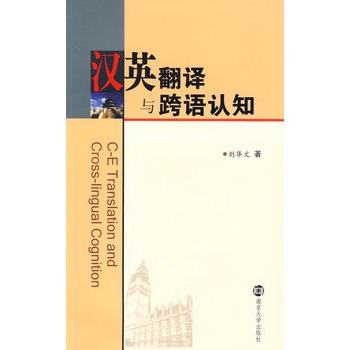《漢英翻譯與跨語認知》是2009年南京大學出版社出版的圖書,作者是劉華文。本書的前九章主要集中在對漢英翻譯過程中語義和句法兩個層面的認知轉化特徵的研究和探討上。
基本介紹
- 書名:漢英翻譯與跨語認知
- 作者:劉華文
- ISBN: 9787305062346
- 出版社:南京大學出版社
基本信息
內容簡介
目錄
1.1 Introduction
1.2 The co-referential relation in C-E translation
1.3 Inter-structural relations between SL and TL
1.4 Conceptual relations between SL and TL
1.5 Conclusion
2 Cognitive abilities in C-E translation
2.1 Introduction
2.2 Images-raw materials for cognitive event in translation
2.3 Cognitive abilities in C-E translation
2.3.1 Recuperation of scene
2.3.2 Selective readjustment
2.3.3 Perspective shifts
2.3.4 Abstraction
2.4 Summary: iconicity as the principle of mechanism for cognitive abilities
3 Cognitive characteristics of re-categorization in C-E translation
3.1 Re-categorization: a cognitive mechanism in translation
3.2 The cognitive characteristics of re-categorization in C-E translation
3.2.1 The confinedness in re-categorization
3.2.2 The split-levelness in re-categorization
3.2.3 The parasiticness of re-categorization
3.2.4 The bi-directionalness in re-categorization
3.3 Conclusion: translational cognitive re-categorization in the light of linguistic philosophy
4 Semantic construction through space blending in C-E translation
4.1 Introduction
4.2 Space blending: a theoretical account
4.2.1 Space blending theory
4.2.2 Cold dish or cold plate?
4.3 Frame, domain, space, script: parameters in cross-lingual space blending
4.3.1 Frame: a parameter pertaining to the spatial proximity within a scene
4.3.2 Domain: a parameter pertaining to the total knowledge involved and the interrelatedness of its constituents
4.3.3 Script: a parameter pertaining to a temporally sequenced space
4.4 Conclusion
5 Two levels of cross-lingual metonymic substitution in C-E translation
5.1 Metonymy in cognitive perspective
5.2 Types of metonymy
5.3 Metaphor-metonymy relationship
5.4 Metonymie approaches to C-E translation
5.4.1 Low-level metonymy
5.4.2 High-level metonymy
5.4.3 Metaphtonymy
5.5 Conclusion
6 Re-lexicalization of motion-event in C-E translation
6.1 Introduction: what is re-lexicalization?
6.2 Re-lexicalization patterns in C-E translation: eventualization,event composition and event decomposition
6.3 Principles in opting for re-lexicalization patterns ".
6.4 Eventualization from verb-weak Chinese
6.5 Re-lexicalization of motion event in C-E translation by composition and decomposition
6.5.1 Motion + Co-Event 1t
6.5.2 Conflation of cause Co-Event onto verb
6.5.3 Conflation of path onto verb
6.5.4 Conflation of figure onto'verb
6.5.5 Conflation of result/effect onto verb
6.5.6 Conflation of ground onto verb
6.6 Translator's two optional tendencies: verb framing and satellite framing
6.7Conclusion: detection of semantic potentials for cross-linguistic lexicalization
7 Re-matching of verb with construction in C-E translation
7.1 Introduction: verb and construction
7.2 Verb-construction links in C-E translation
7.3 The re-matching of equivalent verb for SL with construction
7.3.1 Full compatibility in verb-construction links
7.3.2 Cognitive motivation for verb-construction integration
7.3.3 The main consequence of verb-construction re-matching in C-E translation: a semantic shift
7.4 Conclusion
8 Inter-constructional correlations in C-E translation
8.1 Introduction
8.1.1 Theoretical prerequisites
8.1.2 Tentative observations
8.2 Constructional productivity in C-E translation
8.2.1 Difference in the degree of constructional productivity between Chinese and English
8.2.2 Productivity of English constructions in C-E translation
8.3 Inter-constructional correlations by metonymic inheritance in C-E translation
8.3.1 Sub-partial links in C-E translation
8.3.2 Componential inheritance of predicative verb and argument role
8.4 Inter-constructional correlations by metaphorical extension in C-E translation
8.4.1 Full extension
8.4.2 Argument role contribution
8.4.3 Argument role annulment
8.5 Inter-constructional transformation in C-E translation
8.6 Conclusion
9 Fictivity and factivity of event re-conceptualization in
C-E translation
9.1 Theoretical framework: factivity and fictivity of cognitive conceptualization
9.2 Path specification and event re-conceptualization in C-E translation
9.2.1 Orientation paths
9.2.2 Radiation paths
9.2.3 Shadow paths
9.2.4 Sensory paths
9.2.5 Pattern paths
10 Semantic orientation,syntactic position and pragmatic function of modifier in C-E translation
References
Subject index
Chinese postscript

